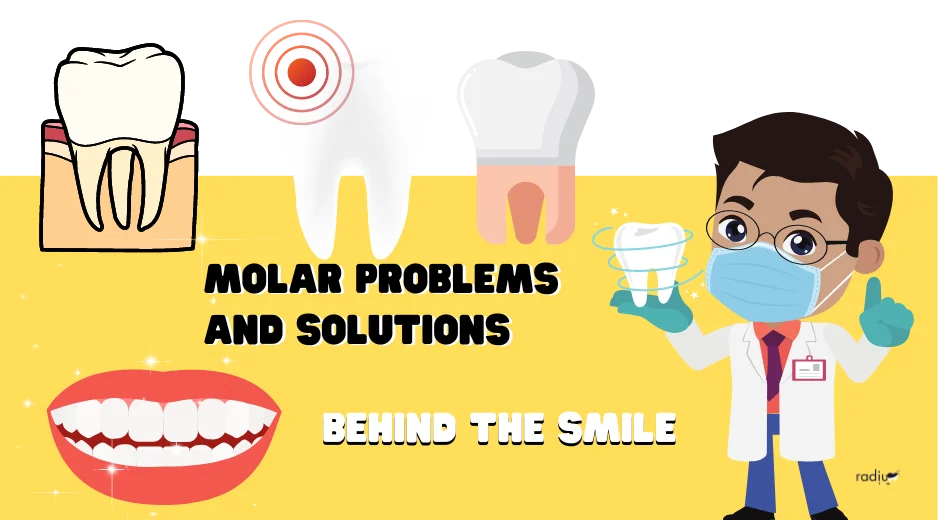Tooth Decay
Tooth decay in molars, the hard-working rear teeth, can occur due to factors like poor oral hygiene, dietary sugars, and bacteria. Discover the causes behind molar decay and how to prevent it through regular brushing, flossing, and a balanced diet low in sugary foods. If decay strikes, various treatments are available, including dental fillings to restore the tooth’s structure. In cases of extensive damage, crowns can be used to protect and strengthen molars. Understanding the causes and options for prevention and treatment empowers you to safeguard your molars and maintain a healthy, confident smile.
Gum Disease
Explore the insidious world of gum diseases that can afflict molars, focusing on periodontitis. Understand the warning signs, including bleeding gums, bad breath, and gum recession, along with risk factors like smoking and diabetes. Learn about effective treatments like scaling and root planing, procedures aimed at deep cleaning and revitalizing the gums and tooth-supporting structures. By delving into the complexities of gum disease, you’ll gain valuable insights into its management, ensuring that your molars stay healthy and firmly rooted, enabling you to maintain a confident and complete smile.
Impacted Wisdom Teeth
Dive into the challenges posed by impacted wisdom teeth, a common dental issue. Uncover the discomfort, pain, and infection that can result from these teeth failing to emerge properly. Learn about the signs indicating when extraction may be necessary to alleviate pain and prevent further complications. Understanding the issues related to impacted wisdom teeth empowers you to recognize the symptoms and make informed decisions about your oral health. Timely intervention ensures relief from discomfort and maintains the well-being of your smile, allowing you to face the future with confidence and comfort.
Bruxism (Teeth Grinding)
Uncover the hidden dangers of bruxism, the habit of teeth grinding. Delve into the impact it has on your molars, leading to wear, fractures, and discomfort. Explore preventive strategies like stress management and custom-fitted nightguards that shield your molars while you sleep. Discover how dental interventions, such as dental splints or orthodontic treatments, can alleviate the effects of bruxism and preserve your precious molars. By addressing this common issue, you not only protect your molars but also safeguard your overall oral health, ensuring your smile remains confident and pain-free for years to come.
Molar Fractures
Explore the world of molar fractures, discovering the types and common causes behind these dental injuries. From small chips to more extensive breaks, learn about the range of molar fractures that can occur. Dive into the realm of dental solutions, including bonding, veneers, or crowns, each tailored to the severity of the fracture. Understand how these treatments can restore the appearance and functionality of damaged molars, allowing you to confidently share your smile with the world. By familiarizing yourself with molar fractures and their remedies, you can ensure that your oral health remains strong and your grin remains radiant.
Sensitivity
Delve into the world of molar sensitivity, uncovering the triggers behind those sharp twinges. Understand the factors like hot or cold foods, acidic drinks, or gum recession that can lead to molar discomfort. Explore effective strategies to alleviate sensitivity, including desensitizing toothpaste that forms a protective barrier, fluoride treatments to strengthen enamel, or dental bonding to shield exposed roots. By comprehending the causes and available remedies for molar sensitivity, you can regain control over your oral comfort, ensuring that your smile remains pain-free and your confidence shines through every grin.
Malocclusion (Misaligned Teeth)
Embark on a journey to understand malocclusion, the condition of misaligned molars that can impact your bite and overall dental health. Explore the common alignment issues such as overbites, underbites, and crossbites that affect molars. Dive into the world of solutions, including traditional braces for precise correction, clear aligners for discreet realignment, and various orthodontic treatments tailored to your specific needs. By unraveling the complexities of malocclusion and its treatments, you can make informed choices to achieve a well-balanced bite, enhancing both your oral health and your confident, aligned smile.
FAQ’s
Q1: What are the common signs of a molar cavity?
A1: Common signs include tooth sensitivity, pain when biting or chewing, visible pits or holes in the tooth, and localized discoloration.
Q2: Is gum disease only a concern for adults?
A2: No, gum disease can affect individuals of all ages. It’s essential to maintain good oral hygiene from childhood to prevent it.
Q3: How long does recovery take after wisdom tooth extraction?
A3: Recovery time varies but typically ranges from a few days to a couple of weeks. Your dentist or oral surgeon will provide specific guidance.
Q4: Can teeth grinding (bruxism) be cured completely?
A4: While there may not be a complete cure, management strategies like nightguards and stress reduction can effectively control bruxism and its effects.
Q5: Do all molar fractures require dental crowns?
A5: No, the treatment depends on the severity of the fracture. Minor chips may only require bonding or veneers, while more extensive fractures may necessitate crowns.
Q6: Is molar sensitivity a common issue, and can it be prevented?
A6: Molar sensitivity is common but can often be prevented or managed through good oral hygiene, avoiding acidic foods, and using desensitizing toothpaste.
Conclusion
In the journey we’ve taken “Behind the Smile,” we’ve unraveled the mysteries of common molar problems and their solutions. From tooth decay to gum disease, impacted wisdom teeth to bruxism, molar fractures to sensitivity, and malocclusion, we’ve delved deep into the world of molars.
Through understanding the causes, recognizing the signs, and exploring a range of treatments, we’ve empowered ourselves to take charge of our oral health. With proactive prevention, timely intervention, and informed choices, we can ensure that our molars remain strong, healthy, and pain-free.

